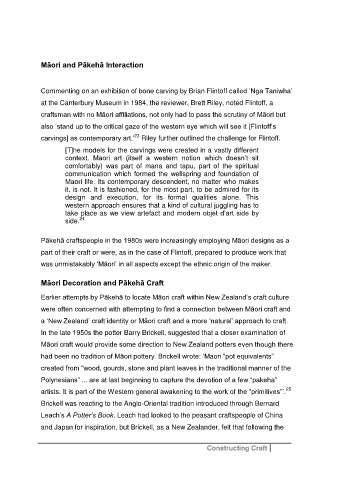Page 266 - Constructing Craft
P. 266
Māori and Pākehā Interaction
Commenting on an exhibition of bone carving by Brian Flintoff called ‘Nga Taniwha’
at the Canterbury Museum in 1984, the reviewer, Brett Riley, noted Flintoff, a
craftsman with no Māori affiliations, not only had to pass the scrutiny of Māori but
also ‘stand up to the critical gaze of the western eye which will see it [Flintoff’s
23
carvings] as contemporary art.’ Riley further outlined the challenge for Flintoff.
[T]he models for the carvings were created in a vastly different
context. Maori art (itself a western notion which doesn’t sit
comfortably) was part of mana and tapu, part of the spiritual
communication which formed the wellspring and foundation of
Maori life. Its contemporary descendent, no matter who makes
it, is not. It is fashioned, for the most part, to be admired for its
design and execution, for its formal qualities alone. This
western approach ensures that a kind of cultural juggling has to
take place as we view artefact and modern objet d’art side by
24
side.
Pākehā craftspeople in the 1980s were increasingly employing Māori designs as a
part of their craft or were, as in the case of Flintoff, prepared to produce work that
was unmistakably ‘Māori’ in all aspects except the ethnic origin of the maker.
Māori Decoration and Pākehā Craft
Earlier attempts by Pākehā to locate Māori craft within New Zealand’s craft culture
were often concerned with attempting to find a connection between Māori craft and
a ‘New Zealand’ craft identity or Māori craft and a more ‘natural’ approach to craft.
In the late 1950s the potter Barry Brickell, suggested that a closer examination of
Māori craft would provide some direction to New Zealand potters even though there
had been no tradition of Māori pottery. Brickell wrote: ‘Maori “pot equivalents”
created from “wood, gourds, stone and plant leaves in the traditional manner of the
Polynesians” ... are at last beginning to capture the devotion of a few “pakeha”
25
artists. It is part of the Western general awakening to the work of the “primitives”’.
Brickell was reacting to the Anglo-Oriental tradition introduced through Bernard
Leach’s A Potter’s Book. Leach had looked to the peasant craftspeople of China
and Japan for inspiration, but Brickell, as a New Zealander, felt that following the
Constructing Craft

